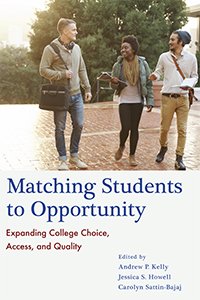 Matching Students to Opportunity: Expanding College Choice, Access, & Quality
Matching Students to Opportunity: Expanding College Choice, Access, & Quality
Edited by Andrew P. Kelly, Jessica S. Howell, and Carolyn Sattin-Bajaj
Harvard Education Press, 2016.
By Eric Johnson
Contributing Editor
Our country leaves a lot of talent on the table.
That’s the overwhelming message of Matching Students to Opportunity, a wonky tome of higher education research edited by Jessica Howell, Carolyn Sattin-Bajaj, and Andrew Kelly.
It’s not exactly a beach read, but the policy-rich book is worth examining for anyone interested in North Carolina’s educational future. That’s because Kelly, a well-respected analyst for the American Enterprise Institute, is now the UNC system’s senior vice president for strategy and policy. He’ll be a key voice in shaping the state’s public universities in the years ahead.
“Colleges are creatures of the policy environment in which they operate,” Kelly and his co-editors write in the introduction. “The incentives to expand enrollments or adopt promising practices, and the resources necessary to do so, are often absent.”
In other words, colleges may need a policy nudge — and additional investment — to make improvements. Research and recommendations alone aren’t enough; policymakers have to set the right incentives. And right now, national and state policies leave too many qualified students without good options for earning a degree. Low-income students, even when they have grades and test scores that predict success, too often languish in underperforming institutions.
Fixing those inequities will depend on major changes to public universities, since that’s where the vast majority of students are educated. In 2014, there were more than 13 million students in public universities, and just 2.8 million in private nonprofit schools.1
Matching Students to Opportunity brings a much-needed focus back to the state-funded workhorses of higher education. Any policy aimed at improving access or results for a broad swath of American students must focus on public institutions.
In an essay looking at the potential for boosting college access, Kelly concludes that improved quality at four-year public campuses is crucial. Schools that already boast strong graduation rates have limited appetite for expansion, so major gains in degree attainment will have to come less from moving students around and more from improving graduation rates where students are.
“Reforming institutions, rather than just changing the flow of students to them, is key to making significant improvements in student success,” Kelly writes. “Raising average- or poorly performing institutions up will multiply the number of quality seats available.”
That means doing the hard work of shoring up big regional schools that educate most American undergraduates. For all the hype about encouraging high-performing students to apply to more rigorous schools — a step Kelly and others support — creating a better “match” won’t go far enough. For that, whole schools must get better at helping students earn a degree, which means difficult changes in academic advising, financial aid, retention efforts and curriculum design.
“Perfect matching is simply inadequate — both in terms of increasing enrollment and in increasing bachelor’s degree attainment,” writes Michael Bastedo, professor at the University of Michigan. “We are closer than ever to having significant answers to these challenges, but they will require thoughtful reflection, sustained efforts, and significant financial investments.”
That basic message, that there is no quick fix for the inequities in higher education, is a consistent drumbeat across the essays in this book. One chapter concludes that increased awareness of financial aid doesn’t help much unless it’s accompanied by a substantial increase in actual aid; another finds that state policy can affect college choice, but that only matters if there are high-quality options available.
Text messages, websites and counseling are all helpful. But in the end, for all the policy ideas and economic nudges researchers have identified to help improve student decision-making, money still matters.
“Improving the quality of higher education is likely to carry a substantial price tag — one that will probably pay off in the long run but create shorter-run fiscal concerns,” writes Robert Kelchen, a professor at Seton Hall University.
Until policymakers are willing to make that tradeoff — short-term investment for long-term gain — higher education reform is just nibbling around the edges.
1 http://nces.ed.gov/programs/digest/d15/tables/dt15_303.70.asp

Leave a Reply